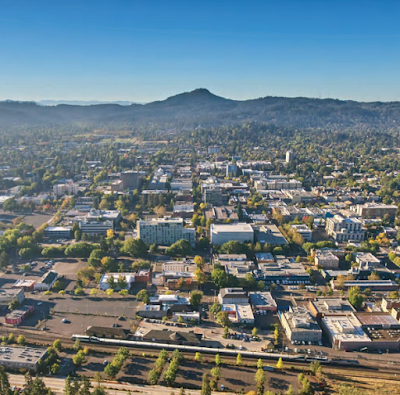(Images from the Engage Eugene website)
“What’s
in a name? That which we call a rose By any other name would smell as sweet.”
(William
Shakespeare, Romeo and Juliet) Shakespeare didn’t think names should matter much. Romeo’s family name was an obstacle between him and Juliet. She could not freely love him because he was a Montague, from a rival house to that of her family’s. Juliet lamented that merely his name could be a barrier between them.
The fact is names do matter. We name things to help us know how they fit into our view of the world. When we hear names, whether they belong to persons, objects, or places, they tell the world something about the people who chose them—their beliefs, what is important to them, how they identify themselves and their kin.
Place-names are especially notable because they reflect the values of a community and what that community considers of social importance. Place-names are often a means of preserving the cultural heritage of a district or town, becoming a part of the linguistic and local identity of the people who live there.
The need to choose street names for the future Downtown Riverfront district in Eugene presented the city with an opportunity to contribute toward the perceptions of who we are and how we present ourselves to visitors from elsewhere.
Though naming is sometimes spontaneous or established through persistence of popular usage (think of Kesey Square in Eugene, which began its life as Broadway Plaza), we mostly choose street names nowadays through official processes intended to be as considerate as possible of tradition, history, and other factors of worth to a plurality of the community. In the case of the new Downtown Riverfront streets, the City of Eugene issued an open call for name ideas. More than 600 people responded(1) , contributing about 1,100 suggestions. The City winnowed down the list to 12 possible names, which it then presented to everyone for online voting through the Engage Eugene website. Voting concluded on October 18, and Mayor Lucy Vinis then reviewed the top-scoring choices and selected the final names.
“The creativity of our community really came through with all of the name suggestions,” the mayor said at last Tuesday’s media event revealing the names for three new streets. “It has also been an opportunity to learn more about our own history as a city and highlight stories we may not often hear. I’m excited that we are at this point and look forward to walking down these streets to the river soon!”
Here are the names for the new streets and what or who they represent:
Annie Mims Lane
Annie Mims and her husband were the first African American family to own a home in Eugene at a time when African Americans were excluded from living in the city limits and redlining was rampant. The Mims’ opened their home and guest house to African American laborers, performers, athletes, students, and others in need of a place to stay when hotels and businesses refused service to African American people prior to public accommodation laws.
Nak-nak Avenue
Nak-nak (pronounced knawk-knawk) is the indigenous Kalapuya word for “duck.” Indigenous Kalapuya occupied much of our area until the 1830s, when many died of infectious diseases brought to the area by white explorers and traders. In 1855 the Kalapuya Treaty was signed handing over much of the Willamette Valley to the United States. At the time of the treaty, it’s estimated that only 400 Kalapuya remained.
Wiley Griffon Way
Wiley Griffon was among Eugene’s earliest documented African American residents. He drove Eugene’s first horse drawn streetcar system and later worked as a janitor at the University of Oregon. He remarkably owned a home near the Riverfront at what is presently E. 4th and Mill during a time when African American people were excluded by law from living not only in the city limits, but in the state of Oregon.
The new street names will do their part to correct a historically ensconced imbalance by helping tell the much-neglected stories of previously marginalized communities or persons. The new names will provide evidence of Eugene’s cultural richness and contribute toward its unique sense of place in ways “Broadway” or “Washington Street” do not. If it were not for the City of Eugene’s efforts, I may never have known who Annie Mims and Wiley Griffon were, or what the Kalapuya word for “duck” is. Like Mayor Vinis, I’m looking forward to one day strolling the new streets and reflecting upon why their names should be of significance to all of us.
(1) I offered
my own, unsuccessful candidate for one of the street names: Mudhole Way.
Eugene Skinner founded “Eugene City” in 1853, but it was known to many during
its early years as “Skinner’s
Mudhole.”
















